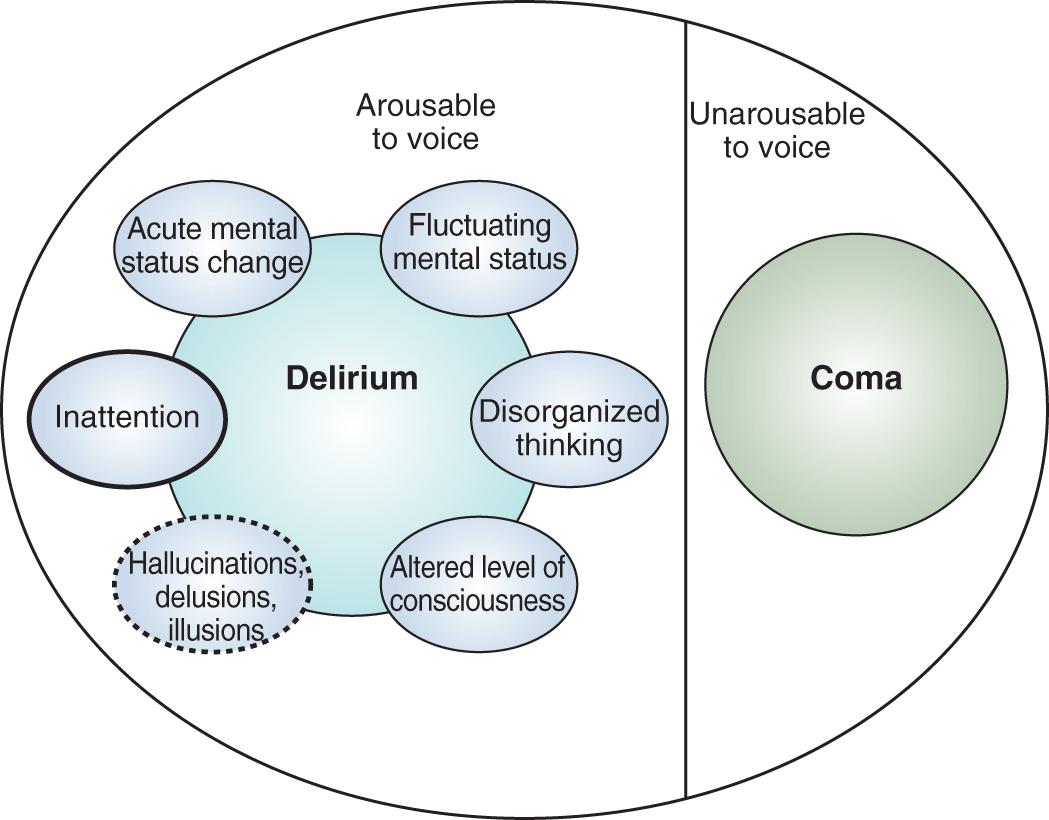Physical Address
304 North Cardinal St.
Dorchester Center, MA 02124
Agitation and delirium are commonly encountered in the intensive care unit (ICU). Although frequently underrecognized, delirium is present in up to 80% of critically ill adults on mechanical ventilation when routinely assessed. Delirium and agitation are more than just an inconvenience; these conditions can have deleterious effects on patient and staff safety and contribute to poor outcomes, including increased duration of mechanical ventilation, increased ICU length of stay, increased risk of death, physical disability, and long-term cognitive impairment. It is therefore important for clinicians to be able to recognize agitation and delirium and to have an organized approach for its evaluation and management.
Agitation is a psychomotor disturbance characterized by excessive motor activity associated with a feeling of inner tension. , The activity is usually nonproductive and repetitious, consisting of behaviors such as pacing, fidgeting, wringing of hands, pulling of clothes, and an inability to sit still. Careful observation of the patient may reveal the underlying intent. In the ICU, agitation is frequently related to anxiety or delirium. Agitation may be caused by various factors: metabolic disorders (hyponatremia and hypernatremia), hyperthermia, hypoxia, hypotension, use of sedative drugs and/or analgesics, sepsis, alcohol withdrawal, and long-term psychoactive drug use, to name a few. , It can also be caused by external factors such as noise, discomfort, and pain. Agitation is important to manage, as it is associated with a longer length of stay in the ICU and higher costs. Symptoms can be mild, characterized by increased movements and an apparent inability to get comfortable, or severe. Severe agitation can be life threatening, leading to higher rates of self-extubation, self-removal of catheters and medical devices, nosocomial infections, hypoxia, barotrauma, and/or hypotension because of patient/ventilator asynchrony. Indeed, recent studies have shown that agitation contributes to ventilator asynchrony, increased oxygen consumption, and increased production of carbon dioxide (CO 2 ) and lactic acid; these effects can lead to life-threatening respiratory and metabolic acidosis.
Delirium can be defined as follows: (1) A disturbance of consciousness (i.e., reduced clarity of awareness of the environment) with reduced ability to focus, sustain, or shift attention. (2) A change in cognition (e.g., memory deficit, disorientation, language disturbance) or development of a perceptual disturbance that is not better accounted for by a preexisting, established, or evolving dementia. (3) The disturbance develops over a short period (usually hours to days) and tends to fluctuate during the course of the day. (4) There is evidence from the history, physical examination, or laboratory findings that the disturbance is a direct physiologic consequence of a general medical condition, an intoxicating substance, medication use, or more than one cause ( Fig. 2.1 ). Delirium is commonly underdiagnosed in the ICU and has a reported prevalence of 20%–80%, depending on the severity of the illness and the need for mechanical ventilation. , , Recent investigations have shown that the presence of delirium is a strong predictor of longer hospital stay, higher costs, and increased risk of death. , , Each additional day with delirium increases a patient’s risk of dying by 10%. Longer periods of delirium are also associated with greater degrees of cognitive decline when patients are evaluated after 1 year. Thus delirium can adversely affect the quality of life in survivors of critical illnesses and may serve as an intermediate recognizable step for targeting therapies to prevent poor outcomes in survivors of critical illness, including depression, posttraumatic stress disorder, and functional disability. ,

Unfortunately, the true prevalence and magnitude of delirium have been poorly documented because myriad terms, including acute confusional state, ICU psychosis, acute brain dysfunction, and encephalopathy, have been used to describe this condition. Delirium can be classified according to psychomotor behavior into hypoactive delirium, hyperactive delirium, or a mixed subtype. Hypoactive delirium, which is the most prevalent form of delirium, is characterized by decreased physical and mental activity and inattention. In contrast, hyperactive delirium is characterized by combativeness and agitation. Patients with both features have mixed delirium. , Hyperactive delirium puts both patients and caregivers at risk of serious injury but fortunately only occurs in a minority of critically ill patients. , Hypoactive delirium might actually be associated with a worse prognosis. , The Delirium Motor Subtype Scale may assist in making this diagnosis.
Although healthcare professionals realize the importance of recognizing delirium, it frequently goes unrecognized in the ICU when not routinely screened for. Even when ICU delirium is recognized, most clinicians consider it an expected event that is often iatrogenic and without consequence. However, delirium needs to be viewed as a form of organic brain dysfunction that has consequences if left undiagnosed and untreated. Given the limited pharmacologic treatment options available, the most effective strategy for reducing its prevalence lies in prevention with nonpharmacologic treatment bundles, the cornerstone of which include routine patient assessments. ,
Become a Clinical Tree membership for Full access and enjoy Unlimited articles
If you are a member. Log in here